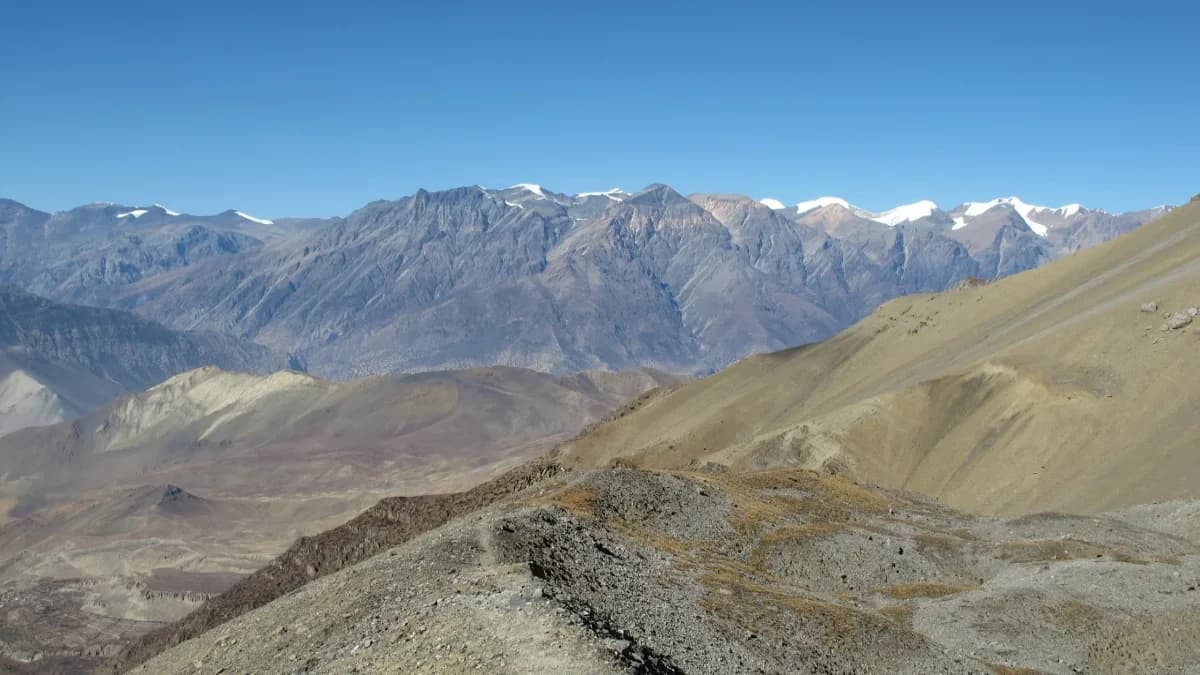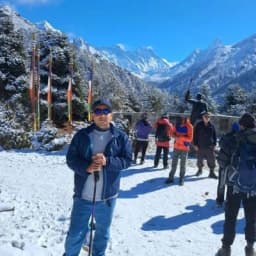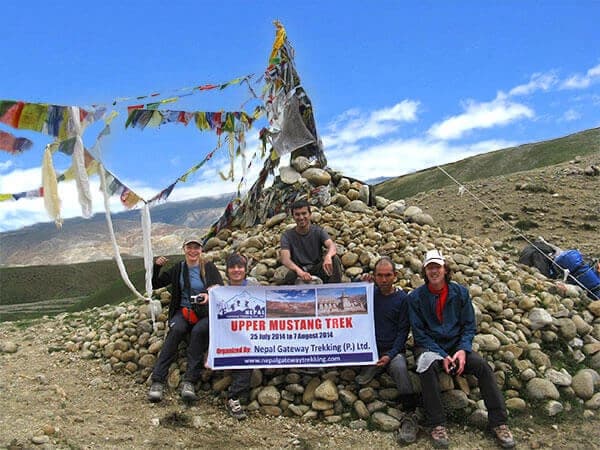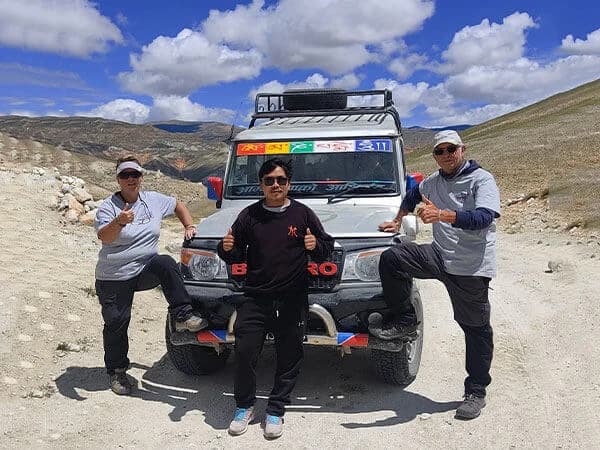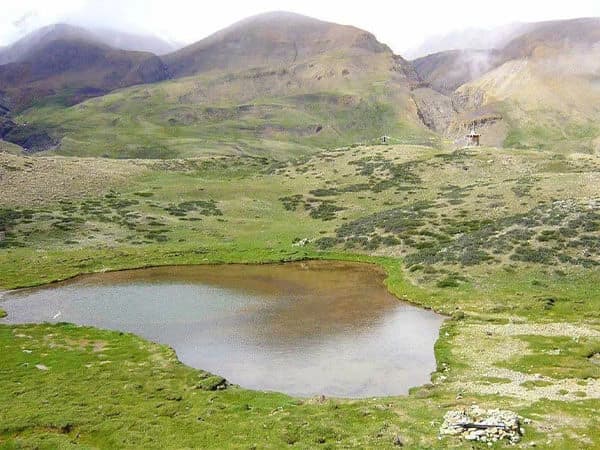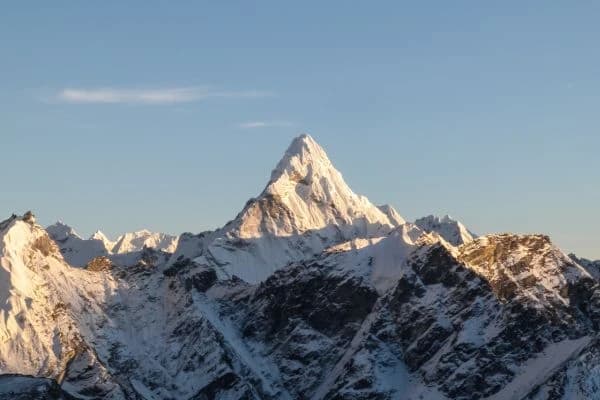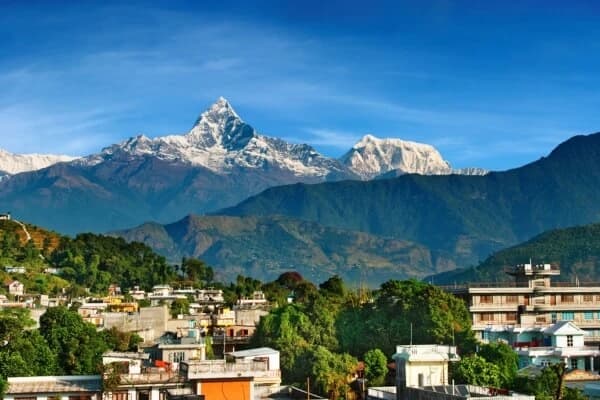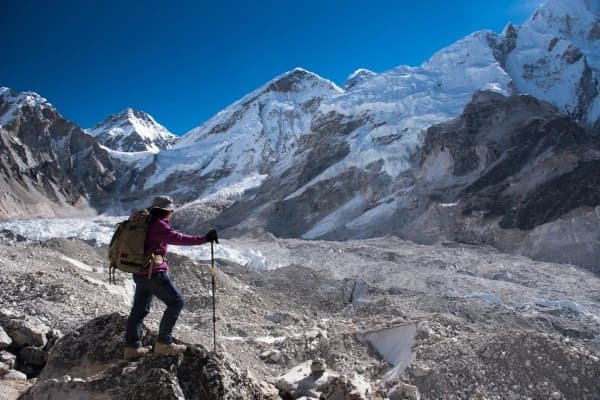Hidden deep in the Himalayas, the Mustang Region Nepal is often called “The Last Forbidden Kingdom.” For hundreds of years, it was closed to outsiders, which helped preserve its unique culture, ancient villages, and amazing landscapes. Today, it is open to travelers who want to explore deserts, walled cities, sacred monasteries, and deep river gorges, all in a place rich with history and Tibetan Buddhist traditions.
Whether you're looking for a few days of trekking, a cultural excursion, or a spiritual journey, the Mustang Region in Nepal has something for you. From Jomsom to the high plateaus of Lo Manthang, each location reveals a narrative of strong people, ancient customs, and breathtaking scenery.
Start planning your Mustang adventure today with Nepal Gateway Trekking and discover the hidden deserts, ancient monasteries, and Tibetan culture that make this region so unique!
Why Should You Visit Mustang?
If you’re searching for a place where culture, adventure, and mystery meet, Mustang should be at the top of your list. Here’s why:
- Unlike popular trekking routes crowded with hikers, Mustang still feels exclusive. Only a limited number of visitors enter Upper Mustang each year, keeping its authentic charm alive.
- The region is home to the Thakali people and Tibetan Buddhist traditions. Colorful festivals, centuries-old monasteries, and mud-brick walled towns like Lo Manthang showcase a way of life that has barely changed for centuries.
- Forget the usual green valleys of Nepal; Mustang greets you with dramatic cliffs, eroded canyons, high desert plateaus, and snow-capped peaks watching from a distance.
- Every type of traveler finds something here, from trekking through Upper Mustang to jeep tours in Lower Mustang, or visiting sacred sites like Muktinath Temple.
- Many travelers describe Mustang as “what Tibet used to be.” Its untouched traditions and landscapes make you feel like you’ve traveled back hundreds of years.
Mustang Region “The Forbidden Kingdom”
The Mustang region, known as the “Forbidden Kingdom of Nepal,” remained closed to foreigners until 1992. Preserving its centuries-old Tibetan-Buddhist traditions and untouched way of life, behind the Annapurna and Dhaulagiri ranges. Its barren cliffs, desert-like valleys, and medieval walled city of Lo Manthang create a landscape unlike elsewhere in Nepal. Visiting Upper Mustang still requires a special restricted area permit, adding to its exclusivity and mystique.
Mustang is about landscapes and a journey into ancient culture and spirituality. From sacred caves and centuries-old monasteries like Thubchen and Jampa to the vibrant Tiji Festival. With its colorful masked dances, the region provides a rare peek into customs that have survived due to seclusion. Mustang is a location where time slows and prayer flags flutter in the frigid winds, making it a truly hidden Himalayan gem.
Upper Mustang vs Lower Mustang
Travelers often wonder: Should I visit Upper Mustang or Lower Mustang? The answer depends on what kind of adventure you’re seeking.
- Upper Mustang
- Once a restricted kingdom, Upper Mustang is still protected by special permits.
- Its capital, Lo Manthang, is a walled city filled with monasteries, palaces, and a maze of alleys.
- The landscapes here are otherworldly — think red cliffs, wind-eroded caves, and desert valleys.
- Trekking is the main way to explore, though jeep tours are slowly opening up the area.
- Lower Mustang
- Easier to reach, more affordable, and accessible without a restricted permit.
- Famous for Muktinath Temple, apple orchards, and Thakali villages offering delicious local meals.
- Ideal for shorter treks, jeep tours, and travelers who want a taste of Mustang without going deep into the high desert.
In short: Upper Mustang is for those who want exclusivity and mystery, while Lower Mustang offers a lighter, more budget-friendly glimpse of Mustang’s culture and beauty. Here’s a detailed comparison:
|
Feature |
Upper Mustang Nepal |
Lower Mustang Nepal |
|---|---|---|
|
Terrain |
High desert and rugged cliffs |
River valleys with greener trails |
|
Culture |
Tibetan Buddhist, Lo Manthang walled city |
Thakali & Loba villages with Hindu influences |
|
Trekking Difficulty |
Moderate, 10 to 14 days |
Beginner-friendly, 5 to 7 days |
|
Accessibility |
RAP required, remote trails |
ACAP & TIMS permits and easier access |
|
Attractions |
Lo Manthang, Chhoser Sky Caves |
Jomsom, Kagbeni, Muktinath |
|
Activities |
Cultural trekking, photography, and desert landscapes |
Short treks, jeep safari, and festivals |
Geography and Best Time to Visit Mustang Nepal
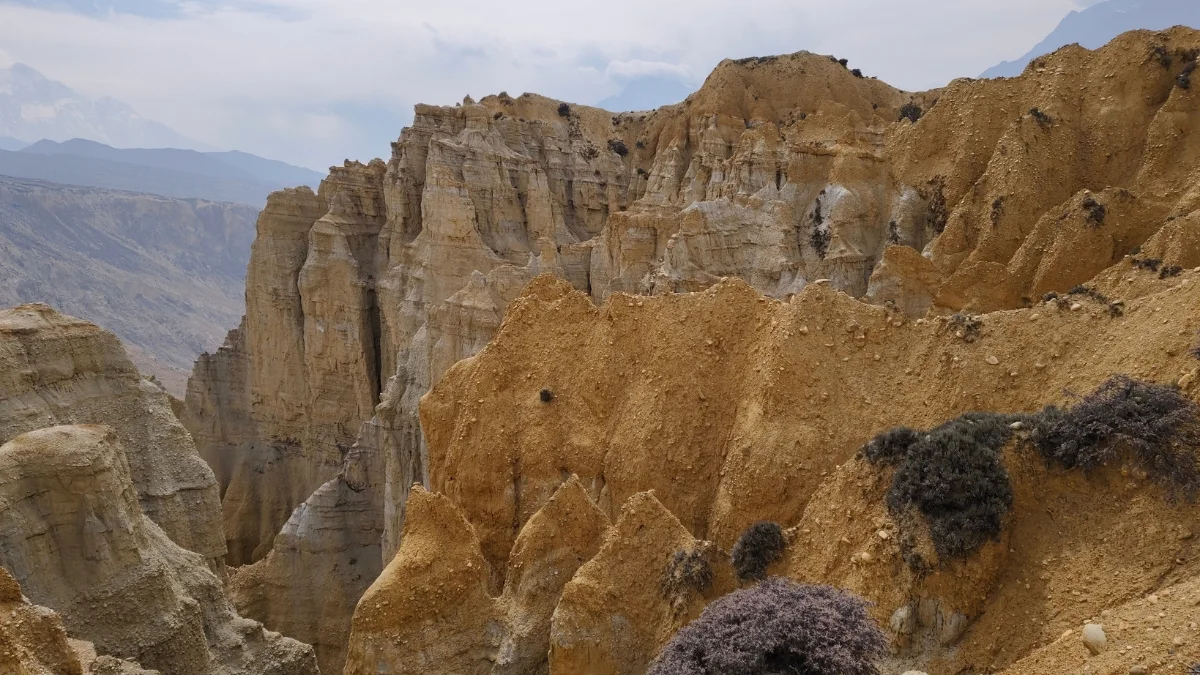
The Mustang Region Nepal sits in northern Nepal, next to Tibet in the north and the Kali Gandaki River in the south. Its geography is very diverse, with deep gorges, barren plateaus, caves, and snow-capped peaks. Because it sits in the rain shadow of the Annapurna and Dhaulagiri ranges, Mustang has a dry, desert-like climate, a sharp contrast to the lush greenery found in much of Nepal. The region can be split into three zones:
- Lower Mustang Nepal: Fertile valleys and villages, accessible via Jomsom and Kagbeni.
- Upper Mustang Nepal: An Arid plateau with high deserts, cliffs, and remote settlements.
- Alpine and River Valleys: Along Kali Gandaki and tributaries, greener areas for trekking.
Climate Zones
- Semi-arid plateau: Dry, desert-like, very hot in the day and cold at night.
- Alpine: Cold, windy, sparse plants at higher altitudes.
- River valleys: Moderate climate with farming and villages.
Wildlife & Biodiversity in Mustang
Despite its desert-like, high-altitude terrain, the Mustang region is home to a surprising range of wildlife and biodiversity. You may spot blue sheep, Himalayan griffons, lammergeiers, and Tibetan snowcocks soaring above the cliffs.
The area also shelters some of the rare and hard-to-find species like the snow leopard and the Himalayan marmot. While its sparse vegetation also supports unique alpine flora throughout its region, which has already adapted to the dry, rain-shadow environment. Mustang’s diverse ecosystem adds a layer of wonder to its dramatic landscapes, making it a paradise for nature enthusiasts and wildlife lovers.
Best Time to Visit
The best time to visit the Mustang region is the spring (March to May) season and the autumn (Sep to Nov) season. These two months offer clear skies, moderate temperatures, and excellent visibility of the snow peaks, making it the best time for trekking and exploring the unique landscapes of Upper Mustang. Spring brings blooming rhododendrons and vibrant valleys, while autumn provides fresh mountain air and stunning mountain vistas.
Visiting during these periods also means you can comfortably navigate the desert-like trails, ancient monasteries, and traditional villages without the challenges of heavy rain or harsh winter cold. The weather is stable, roads are accessible, and the overall trekking experience is far more enjoyable, allowing travelers to fully immerse themselves in the culture, scenery, and serene beauty of Mustang.
Seasonal Travel Guide
|
Season |
Conditions |
Best For |
|---|---|---|
|
Spring (Mar-May) |
Clear skies, moderate temps, and blooming flora |
Trekking, photography, festivals |
|
Summer (Jun-Aug) |
Rain-shadow regions remain accessible but do have occasional landslides |
Trekking (limited), jeep safari |
|
Autumn (Sep-Nov) |
Stable weather, crisp air, peak trekking season |
All activities, photography |
|
Winter (Dec-Feb) |
Cold, arid winds and snow at higher altitudes |
Cultural immersion, festivals, and low tourist traffic |
Activity-Based Recommendations:
- Trekking: Best in Spring and Autumn
- Jeep Safari: Go in Spring, Autumn, or early Winter
- Pilgrimage Visits: You can visit them all year, but Winter means it’s extremely cold, and there aren’t many facilities.
With road access improving every year, now is the best time to see Mustang before it changes forever.
History, Culture & Traditions of Mustang
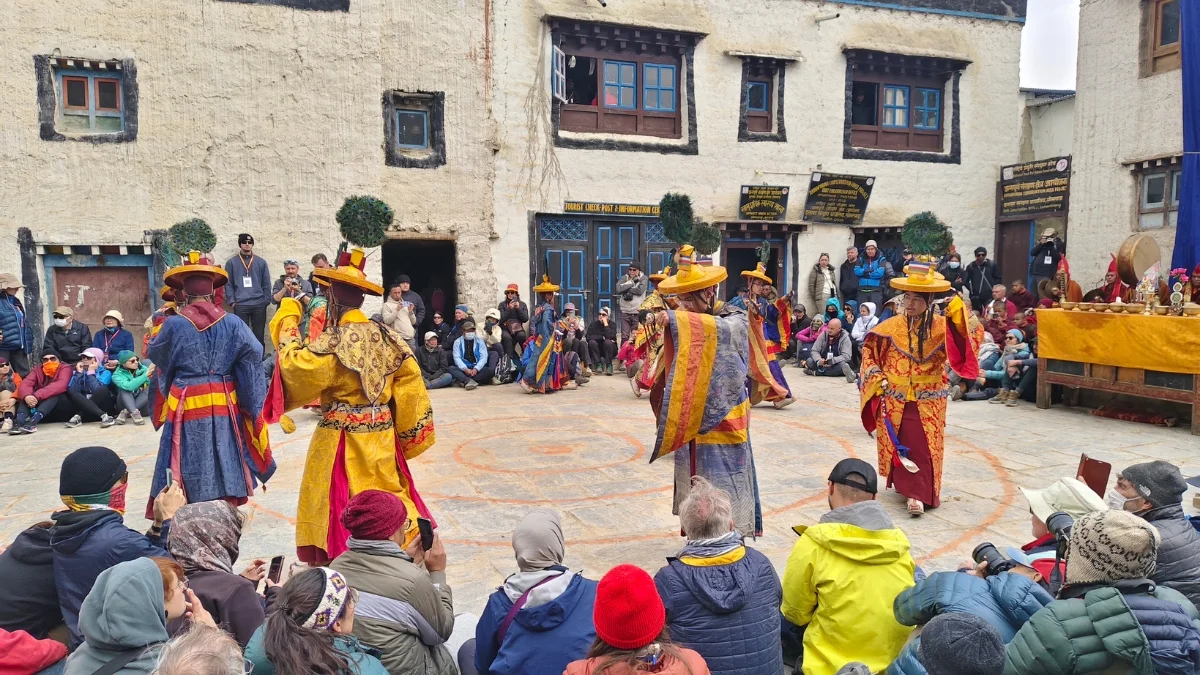
The Mustang Region Nepal was once the Kingdom of Lo, with Lo Manthang as its walled capital. The city shows strong Tibetan Buddhist influence with palaces, monasteries, and walls. It is also a cultural bridge between Nepal and Tibet. The people here, mainly the Thakali and Loba communities, follow Tibetan Buddhism mixed with local customs.
Local Communities:
- Thakali: Known for trade, cuisine, and hospitality
- Loba: Tibetan-speaking people, living primarily in Upper Mustang Nepal
- Tibetan heritage: Monasteries, prayer flags, rituals
Festivals:
- Tiji Festival: This event takes place in Lo Manthang and lasts 3 days, featuring cool masked dances that depict the struggle between good and evil.
- Yartung Festival: A Mustang horse racing festival in Lo Manthang, where people enjoy traditional sports and hang out together.
Cuisine Highlights:
- Thakali Thali: A classic Nepali meal with rice, lentils, pickles, and veggies.
- Tibetan Butter Tea: Salty, super calorie-packed tea that’s great for high-altitude treks.
- Marpha Apple Brandy: A local drink made from apples grown in Mustang’s orchards.
Mustang Must-See Attractions and Highlights
The Mustang Region in Nepal is an amazing mix of history, spirituality, and breathtaking natural beauty. It used to be a closed-off kingdom, but now travelers can check out its old monasteries, holy temples, and jaw-dropping landscapes.
1. Lo Manthang - The Walled City
Lo Manthang, also called the ancient capital city of the Kingdom of Lo, is a walled city that offers a glimpse into a bygone era. Enclosed by a 16th-century mud-brick wall, it houses three major monasteries, a royal palace, and a monastic museum.
The city's architecture and layout reflect Tibetan influences, with narrow alleys and traditional homes. It's a haven for those interested in Tibetan Buddhism and medieval history.
2. Muktinath Temple - A Sacred Pilgrimage Site
Muktinath Temple sits at a high altitude of 3,800 meters and is special for both Hindus and Buddhists. Hindus see it as one of the 108 Divya Desams for Lord Vishnu, and Buddhists believe it represents Avalokiteśvara.
The Muktinath Temple has 108 water spouts gushing out water continuously. People collect water from each of these 108 water spouts as holy water to bring back home. The temple also has a sacred fire inside the premises, symbolizing the elements. It's considered a place of liberation and spiritual significance.
3. Kagbeni - Gateway to Upper Mustang
Kagbeni is an old village right where the Kali Gandaki River meets the Muktinath Valley. It’s the main gateway to Upper Mustang, Nepal, and a starting point for trekkers.
The village has old mud-brick houses, narrow alleys, and ancient monasteries that show Tibetan culture and architecture. It’s also significant for religion, with a long history of pilgrimages and trading.
4. Chhoser Sky Caves - Ancient Cliff Dwellings
The Chhoser Sky Caves is a collection of man-made caves carved into the cliffs of Upper Mustang Nepal. They’re believed to be over 2,000 years old and were used for meditation, shelter, and burials.
Lots of the caves have Buddhist artifacts, paintings, and old manuscripts from the 12th to 14th centuries. Their amazing location and history make them a must-see for anyone who loves history or trekking.
5. Marpha Village - The Apple Capital
Marpha Village is famous for its abundance of apple orchards and the old Thakali culture. The weather there is just right for growing lots of apple types, making it a cool place for apple stuff like cider and brandy.
Marpha's cobblestone streets, whitewashed houses, and Buddhist shrines add charm. It's also home to a horticulture farm established in 1966, which has been instrumental in developing apple cultivation in the region.
6. Jomsom - The Gateway to Mustang
Jomsom serves as the main entry point to the Mustang Region Nepal, with a small airport connecting it to Pokhara. The scenic flight offers views of the Annapurna and Dhaulagiri mountain ranges. Jomsom is a bustling town that acts as a base for trekkers heading to destinations like
Muktinath and Lo Manthang. Its strategic location and infrastructure make it a convenient starting point for exploring Mustang.
7. Kali Gandaki Gorge - The Deepest Gorge
The Kali Gandaki Gorge, made by the Kali Gandaki River, is thought to be one of the deepest gorges in the world. It sits between the huge peaks of Annapurna I and Dhaulagiri, both over 8,000 meters high. The gorge gives amazing views and is an important natural feature of the area.
8. Dhumba Lake
Dhumba Lake, near Jomsom in the Mustang area, is a tranquil freshwater lake surrounded by lush green trees and steep hills. It has enormous religious significance for both Hindus and Buddhists and attracts local pilgrims all year round. The lake's crystal-clear waters mirror the surrounding mountains, creating a picturesque environment that will appeal to both photographers and wildlife enthusiasts.
Dhumba Lake's accessibility from the main trekking routes and its spiritual and natural beauty make it one of the must-visit attractions in Mustang. It offers trekkers a peaceful retreat amidst the region's dramatic landscapes.
Explore Mustang’s hidden gems with our detailed trekking guide, from Lo Manthang to the Chhoser Sky Caves, and make the most of your journey!
How to Reach the Mustang Region?
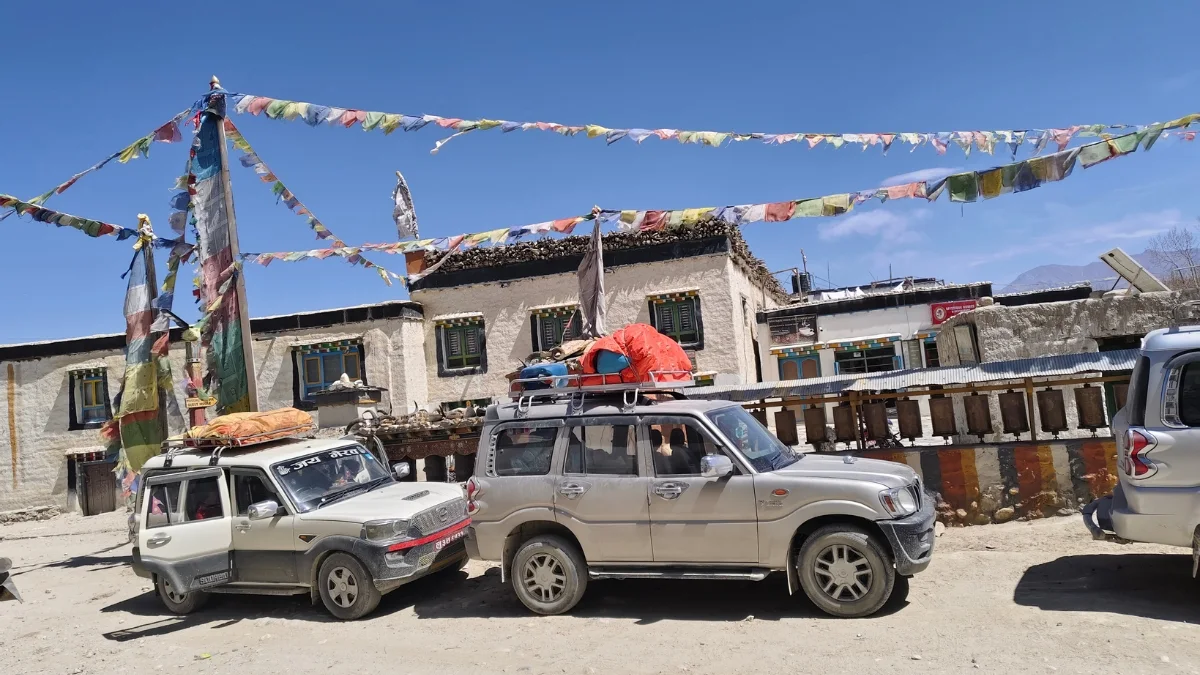
Mustang’s remoteness requires careful travel planning. There are three main ways to reach the region:
1. By Flight
- Route: Kathmandu → Pokhara → Jomsom.
- Duration: Around 30 minutes from Pokhara to Jomsom.
- Pros: Really fast, awesome views of the Himalayas, almost no road travel.
- Cons: Weather can mess things up; flights might get delayed or canceled if the wind is strong.
2. By Road / Jeep
- Route: Pokhara → Beni → Jomsom → Kagbeni → Lo Manthang.
- Duration: 2 to 3 days, with stops during the drive for local views.
- Benefits: Feels like an adventure where you can go at your own pace.
- Challenges: Ragged roads, with long travel times due to traffic, and not comfortable compared to flights.
3. By Trekking
- Lower Mustang Trek: Jomsom → Kagbeni → Muktinath.
- Upper Mustang Trek: Lo Manthang trek starting from Kagbeni.
- Benefits: Immersive, scenic, cultural experience.
- Challenges: Upper Mustang is longer and requires days of fitness and preparation, and a registered guide is mandatory.
Alternative Options:
- Jeep safaris and helicopter tours provide comfortable shortcuts and can reach remote villages far more easily than trekking. Thus, this approach is ideal for trekkers with limited time.
Book your scenic flight or fun jeep safari to Mustang with Nepal Gateway Trekking today and enjoy jaw-dropping Himalayan views from your seat or ride!
Trekking Routes & Itineraries in Mustang
Mustang is a trekker’s dream, with routes that show off amazing landscapes, old culture, and cool Tibetan-influenced heritage. From high desert views to sacred temples, every trek gives a unique experience for both beginners and experienced trekkers.
- Upper Mustang Trek (12–14 days): The crown jewel of Mustang. Starts from Jomsom and leads you into Lo Manthang through barren cliffs, caves, and remote villages.
- Lower Mustang Trek (5–7 days): A shorter, easier journey exploring Kagbeni, Muktinath, and Marpha. Perfect if you want Mustang’s highlights without long trekking days.
- Jeep Tours: Roads now reach Lo Manthang, making jeep safaris a popular option. Great for travelers with limited time or those who prefer comfort over trekking.
- Annapurna Circuit with Mustang Extension: Combine the classic Annapurna Circuit with a detour into Mustang for a truly diverse adventure.
Upper Mustang Nepal Trek
The Upper Mustang Trek spans 10-14 days and covers approximately 120-150 km round trip. Considered moderate in difficulty, this trek requires a licensed guide due to its location in the restricted area of Upper Mustang.
The Upper Mustang Nepal Trek highlights include the walled city of Lo Manthang, Chhoser Sky Caves, and Luri Gompa, all set against vast desert landscapes and towering cliffs. Trekkers can explore traditional villages, interact with local communities, and witness centuries-old Tibetan Buddhist culture, making it a truly immersive experience.
Upper Mustang Trek Itinerary (12 Days)
| Day | Route |
Highlights |
|---|---|---|
|
Day 1 |
Pokhara → Jomsom (Flight) → Kagbeni |
Scenic flight, gateway village to Upper Mustang |
|
Day 2 |
Kagbeni → Chele |
First glimpse of high desert landscapes and cliffside caves |
|
Day 3 |
Chele → Syangboche |
Tibetan-influenced villages, crossing small passes |
|
Day 4 |
Syangboche → Ghami |
Red cliffs, mani walls, and remote settlements |
|
Day 5 |
Ghami → Tsarang |
Tsarang Monastery, cultural encounters |
|
Day 6 |
Tsarang → Lo Manthang |
Enter the walled city, explore palaces and monasteries |
|
Day 7 |
Lo Manthang Exploration |
Day hike to Chhoser Sky Caves and monasteries |
|
Day 8 |
Lo Manthang → Drakmar |
Scenic descent with ancient caves on the route |
|
Day 9 |
Drakmar → Ghiling |
Panoramic mountain views and local interaction |
|
Day 10 |
Ghiling → Chhuksang |
Ancient villages with Tibetan prayer flags and chortens |
|
Day 11 |
Chhuksang → Jomsom |
Retrace the route with stunning views of Nilgiri and Dhaulagiri |
|
Day 12 |
Jomsom → Pokhara (Flight) |
Farewell to Mustang’s highlands |
Also if you are interested to Damodar Kunda, Nepal Gateway Trekking provides Upper Mustang Trek with Damodar Kunda.
You can also explore upper mustang with Upper Mustang Overland Tour.
Lower Mustang Nepal Trek
Made for beginners or people with less time, the Lower Mustang Nepal trek lasts 5-7 days, covering 65-80 km round trip. The trail goes through famous villages like Kagbeni and Marpha, known for their beautiful apple orchards and Thakali culture. And ends at Jomsom, the gateway to Mustang.
The trek ends at the sacred Muktinath Temple, giving both cultural insights and spiritual importance on a route that’s pretty easy to access.
Lower Mustang Nepal Trek Itinerary (6 Days)
|
Day |
Route |
Highlights |
|---|---|---|
|
Day 1 |
Pokhara to Jomsom (Flight) to Kagbeni |
Scenic arrival, traditional Tibetan-style village |
|
Day 2 |
Kagbeni to Muktinath |
Visit to the sacred Muktinath Temple and witness the eternal flame |
|
Day 3 |
Muktinath to Marpha |
Checking out the vast Marpha’s apple orchards and Thakali culture |
|
Day 4 |
Marpha to Tukuche |
Amazing views of Dhaulagiri and traditional Thakali houses |
|
Day 5 |
Tukuche to Jomsom |
Easy walk along the Kali Gandaki riverbed |
|
Day 6 |
Jomsom to Pokhara (Flight) |
A return flight with beautiful mountain views |
Jomsom-Muktinath Trek
For travelers looking for a shorter trip, the Jomsom-Muktinath Trek lasts 3-5 days. It focuses on visiting important Hindu and Buddhist temples while taking in incredible views of the Kali Gandaki Gorge and the surrounding mountains.
Ideal for solo travelers, families, or those short on time, this route combines easy terrain with rich cultural and spiritual experiences.
Jomsom-Muktinath Trek Itinerary (4 Days)
|
Day |
Route |
Highlights |
|---|---|---|
|
Day 1 |
Pokhara to Jomsom (Flight) |
Short flight into the Mustang Region Nepal |
|
Day 2 |
Jomsom to Kagbeni |
Visit the historic gateway to Upper Mustang Nepal |
|
Day 3 |
Kagbeni to Muktinath |
Sacred Hindu and Buddhist pilgrimage sites |
|
Day 4 |
Muktinath to Jomsom to Pokhara |
Return trek and flight back to Pokhara |
Pick the trek that’s right for you - Upper Mustang Nepal for remote deserts and culture, or Lower Mustang Nepal for a shorter, beginner-friendly adventure, and start your trip now!
Mustang Trek Cost Breakdown
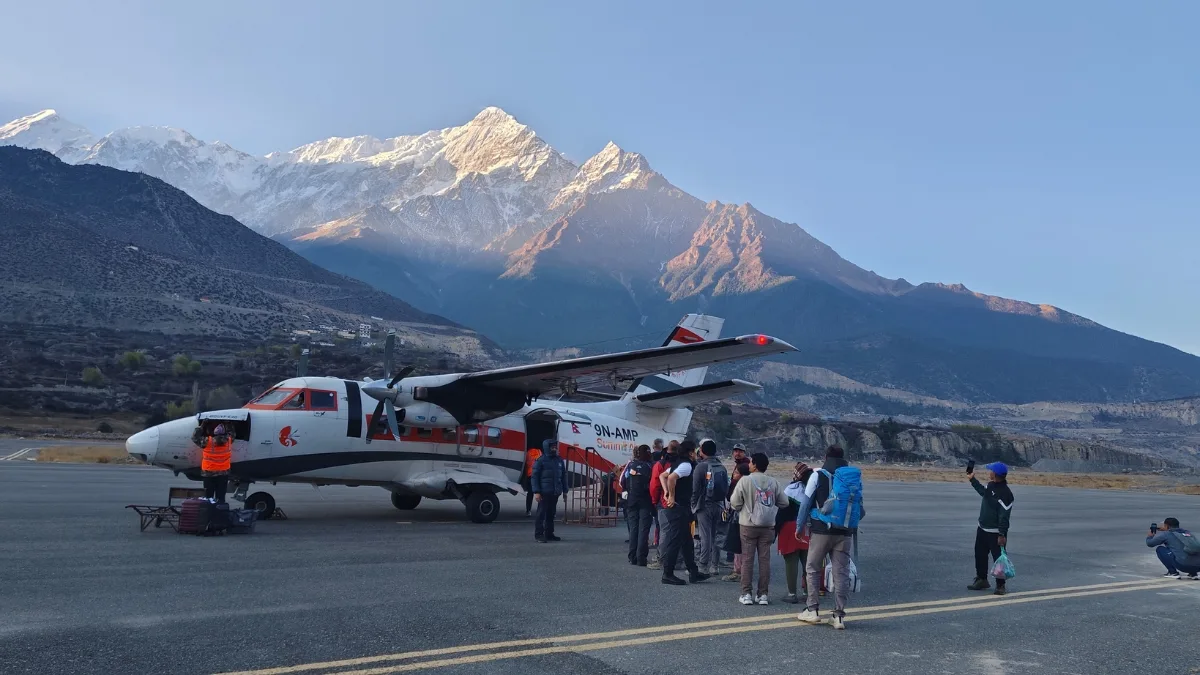
Planning a trip to Mustang means balancing your budget for permits, transport, places to stay, and food, while deciding if you want to trek on your own or with a travel agency. The region has both Upper Mustang Nepal (restricted area) and Lower Mustang Nepal routes, and costs change depending on your plan, comfort, and how you travel.
Trekking on your own can be cheaper, but it needs careful planning, getting permits in advance, and organizing your own transportation.
|
Expense |
Typical Cost (USD) |
|---|---|
|
RAP (Upper Mustang) |
$500 / 10 days |
|
ACAP Permit |
$20 (NPR 3000) |
|
Flight Kathmandu-Jomsom |
$100-150 one-way |
|
Jeep Safari |
$150-200 per day |
|
Accommodation |
$15-50 per night (tea houses & hotels) |
|
Food |
$5-15 per meal |
|
Upper Mustang Package |
$1600-1800 for 14-16 days |
Permits & Fees Required for Mustang Travel
Travel in Mustang is regulated to protect its fragile ecosystem and culture. The permits needed for Mustang region travel are as follows:
- Restricted Area Permit (RAP)
- Annapurna Conservation Area Permit (ACAP)
- Trekkers’ Information Management System (TIMS)
1. Restricted Area Permit (RAP) - Upper Mustang
- Everyone visiting Upper Mustang Nepal must do this.
- Cost: $500 for 10 days, plus $50 for each extra day.
- You need to travel with a licensed guide.
2. ACAP Permit
- Required for trekking in the Annapurna Conservation Area.
- Cost: The permit costs roughly $20, i.e., NPR 3000.
3. TIMS Card (Trekkers’ Information Management System)
- Tracks all trekkers in Nepal for safety and emergency reasons.
- Cost: TIMS card costs around $15, i.e., NPR 2000.
Application Tips:
- You can apply through trekking agencies in Kathmandu or Pokhara.
- You need to get your permits ahead of time, especially in busy trekking seasons.
- If you stay more than 10 days, you have to renew your RAP.
Only a limited number of trekkers enter Upper Mustang each year — making it truly exclusive.
Mustang Region, Nepal - Recent Updates & Travel Insights 2025
The Mustang Region Nepal is changing fast, mixing its old-time cultural charm with easier ways to get around. New roads, trekking routes, and more tourists are making it easier and more exciting for travelers to explore this hidden Himalayan gem.
Tourism Growth
- Total Mustang visitors (all districts): ~144,745 foreign tourists in 2024 (approx. +50% vs 2023).
- Jan-Apr 2025 foreign visitors to Mustang: 51,896 (+36.6% vs Jan-Apr 2024).
- Upper Mustang foreign arrivals 2024: 4,061 (+14.2% vs 2023).
Infrastructure Improvements over the years
- Completion of the Beni-Jomsom-Korala road improves accessibility
- Discussions are ongoing to relax some RAP requirements
New Trekking Routes (2025 Updated)
- Lupra-Muktinath
- Thini-Tilichotaal
- Kokhethati-Sirkung-Sauru-Chokhopani-Dhumbatal
Cultural Spotlight
- “MUSTANG Nostalgia” photo exhibition by Gehendra Dhimal Foundation
- Highlights local heritage and ancient Mustang landscapes
Practical Mustang Travel Tips
- New roads shorten travel times but may change trekking logistics
- Updated permits and new trails require planning 2-3 months ahead
Mustang Hotels and Accommodation
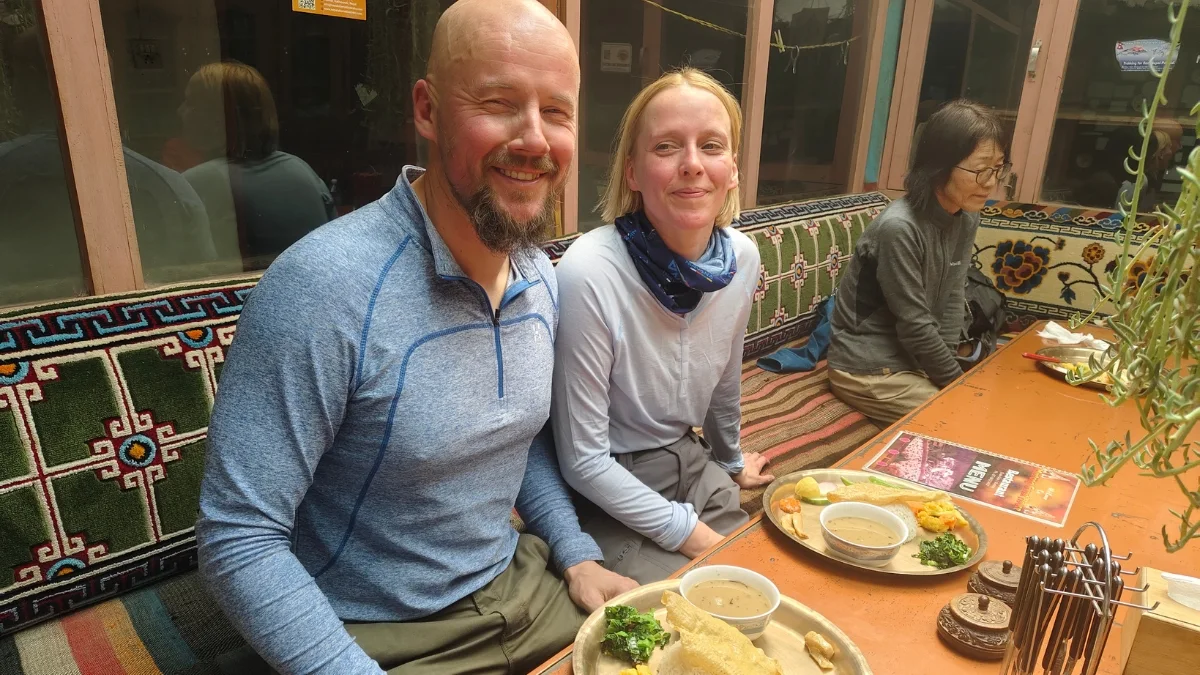
Places to stay and eat in the Mustang Region Nepal fit its rough terrain and rich culture. From simple tea houses along trekking trails to comfy hotels in towns like Jomsom and Lo Manthang, travelers can choose what works best for them.
Local cuisine, influenced by Thakali and Tibetan traditions, adds a unique flavor to the Mustang experience.
Accommodation
- Tea Houses & Guesthouses: Simple places along trekking paths, often with shared rooms.
- Hotels: Found in Jomsom and Lo Manthang, with private rooms and some extras.
- Facilities: Wi-Fi and electricity might be limited; hot showers are available in some lodges.
Food & Cuisine
- Thakali Thali: Traditional Nepali meal set.
- Tibetan Momo: Steamed or fried dumplings.
- Yak Butter Tea: Warm, salty drink for high-altitude energy.
- Apple Brandy (Marpha): Local specialty distilled from apples.
Reserve your tea houses or hotels in advance and experience authentic Thakali cuisine and comfortable stays throughout your Mustang trip!
Safety, Health & Packing Tips for Mustang Region Nepal
Traveling to the Mustang Region Nepal is an amazing experience, but its remote location, high altitude, and limited facilities mean you need to plan carefully. From handling altitude sickness to packing the right gear, being prepared makes your trip safer and way more fun in this unique Himalayan region.
1. Altitude Sickness
Treks in Mustang usually go above 3,500 meters, so altitude sickness (AMS) can happen. Go slow to adjust, don’t rush your plan, and drink plenty of water. Watch out for early signs like headaches, feeling sick, or tiredness to stay safe.
2. Insurance & Evacuation
Travel insurance with high-altitude trekking coverage is highly recommended. Especially for Upper Mustang in emergencies. Though air evacuation services are available from Jomsom to Pokhara or Kathmandu, they can be costly without proper insurance.
3. Road & Trekking Safety
Upper Mustang requires the services of a qualified guide due to its restricted nature and difficult terrain. Follow the marked trekking trails and avoid shortcuts that may be unstable or near dangerous cliffs. Beware of landslides on jeep roads during the rainy season.
4. Packing Essentials
The weather in Mustang can switch a lot between day and night, so packing smart is super important. Take warm clothes, a windproof jacket, and strong trekking gear. Don’t forget sunscreen, since the sun’s rays are stronger at high altitudes.
Must-have items include:
- Clothing: Warm layers, fleece jackets, and windproof jackets.
- Sun protection: Sunglasses, sunscreen, hat, lip balm with high SPF rating.
- Trekking gear: Strong boots, trekking poles, and a comfortable backpack with a cushion, if possible.
- Health & safety: First aid kit, water purification tablets, and your prescribed medications, if any.
- Snacks & hydration: Energy bars, nuts, and a reusable water bottle.
- Cash & connectivity: There are few to no ATMs with weak mobile signals, so always bring enough money for remote spots.
Conclusion - Why Mustang Belongs on Your Travel Bucket List
Mustang is one of those rare places where time seems to have stopped. Its dry valleys, cliff caves, and timeless villages hold stories you won’t find anywhere else in Nepal. Whether you choose the exclusivity of Upper Mustang or the accessibility of Lower Mustang, the journey will leave you with memories for a lifetime.
If Mustang is on your bucket list, don’t wait too long. Roads and modernization are slowly changing their ancient rhythm. Visit now — and walk through a living piece of history before it transforms forever.
Visit Mustang now, before modern roads change its ancient charm forever, in the Last Forbidden Kingdom. Experience a once-in-a-lifetime adventure filled with history, culture, and stunning Himalayan landscapes! Book your next trek to Mustang with Nepal Gateway Trekking.
FAQs - Everything About Mustang Region Nepal Travel
What is the best time to visit Mustang Nepal?
The ideal seasons are spring (March to May) and autumn (September to November) when the weather is stable, skies are clear, and trails are at their most scenic. These months also coincide with major local festivals, adding cultural richness to your trip.
How difficult is the Upper Mustang Trek?
The Upper Mustang Trek is considered moderately challenging. While it doesn’t involve extreme climbing, you’ll trek across rugged, high-altitude terrain. A licensed guide is mandatory, and good physical fitness is highly recommended to enjoy the journey comfortably.
Do I need a special permit to trek in the Mustang Region Nepal?
Yes. To enter Upper Mustang, you must obtain a Restricted Area Permit (RAP), which costs $500 for 10 days and another $50 for each day after the 10 days period. In addition, you’ll need an Annapurna Conservation Area Permit (ACAP) and a TIMS card for trekking in the region.
How many days should I spend in Mustang?
The duration depends on your travel style and trekking goals. Lower Mustang trips can be completed in 5-7 days, while Upper Mustang trekking guides typically take 10-14 days for a full experience of Lo Manthang, monasteries, and desert landscapes.
What is the difference between Upper Mustang & Lower Mustang?
Upper Mustang Nepal is remote, dry, and strongly influenced by Tibetan culture, with ancient caves, monasteries, and the walled city of Lo Manthang. Lower Mustang Nepal is greener, easier to reach, and great for shorter, beginner-friendly treks.
Is altitude sickness a concern in Mustang?
Yes. Treks in Mustang often go above 3,500 meters, so altitude sickness can be a problem. It’s really important to take your time, climb slowly, drink lots of water, and watch for early signs to stay safe.
Can I travel to Mustang by jeep instead of trekking?
Absolutely. Jeep safaris are super popular, especially in Lower Mustang Nepal, letting you reach villages, monasteries, and viewpoints. But in Upper Mustang Nepal, roads are few, so it’s usually best to mix a jeep ride with some short treks.
Is Mustang suitable for beginners/family travel?
Yes, but with conditions. Lower Mustang Nepal is beginner- and family-friendly with easier trails and better facilities. Upper Mustang, however, involves longer treks and higher altitudes, making it more suitable when traveling with a licensed guide.
Are there ATMs & internet in Mustang?
Services are very limited. ATMs and reliable internet are mainly found in Jomsom and Lo Manthang, so it’s best to carry enough cash and not rely heavily on digital connectivity during your trip.
Can I visit Mustang during the monsoon?
It’s not recommended to visit during the monsoon season (June to August) as heavy rains can make roads and trekking trails dangerous due to landslides and slippery terrain. Opt for spring or autumn for a safer and more enjoyable journey.
